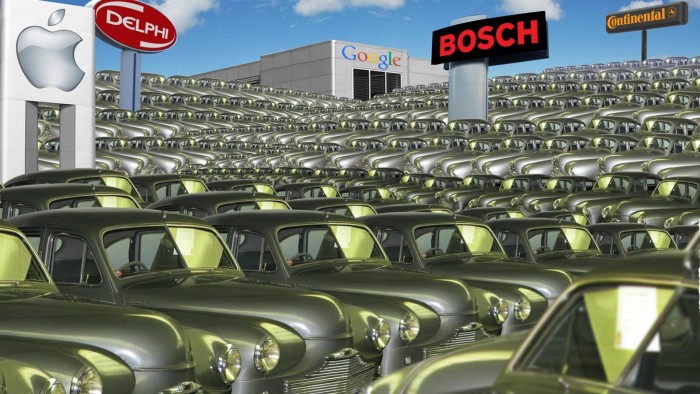Software is steering auto industry


Roula Khalaf, Editor of the FT, selects her favourite stories in this weekly newsletter.
Here is a quiz: with which big three auto companies has Google partnered to build a self-driving car? If you guessed Ford, General Motors and Fiat Chrysler, you are wrong. The correct answer is Bosch, Continental and Delphi, three of the industry’s global suppliers.
It is an easy error to make. Although much of the technology that guides and controls cars is built by suppliers, even the biggest of them is little known outside the industry. The balance of power, and most of the market value, lies with the “original equipment manufacturers” that assemble vehicles and sell them to consumers.
But competition is intensifying as Google and Apple enter the market. Google is testing a self-driving car that uses Bosch sensors. No one knows precisely what Apple is doing, but it is employing several hundred people on a project called Titan. Along with Elon Musk’s Tesla, Silicon Valley companies are challenging Detroit.
The challenge is not merely external. As software and communications become as integral to a new generation of vehicles as hardware, the tradition of OEMs being able to control and squeeze their suppliers is shifting. There is a revolution from below.
This revolution makes it possible for a technology group to be a car company, as Tesla has shown. It may even be possible to thrive without being either an OEM or a supplier — the idea that Google is exploring. As with computers and mobile phones, they could own technology and license software, rather than shaping metal.
Marc Andreessen, the venture capitalist, proclaimed in 2011: “Software is eating the world.” Software is starting to steer the car industry — to redirect the way in which it has been organised since Henry Ford and Alfred Sloan of General Motors placed assembly companies at its heart.
The role of global suppliers — companies such as Bosch and Continental of Germany and Denso of Japan — has been growing for some years. They invest heavily in research and development on electronics and automation, and have higher margins than OEMs. Bosch’s mobility division employs 34,000 engineers, of which about a third work in software.
Podcast
How Apple can join the automotive industry

Apple is revving up to join the automotive industry. Last week, the Financial Times reported that Apple is recruiting experts from the car business to work at a new, top-secret research lab. Ravi Mattu, the FT’s technology editor talks to Tim Bradshaw, our San Francisco correspondent, to find out how a company known for computers and mobile phones can enter a new sector like this.
When cars were mechanical, the companies that assembled them from thousands of parts wielded more power than their myriad small suppliers, even though they were heavily outnumbered. Four-fifths of the jobs in the industry in Tennessee, for example, are still provided by suppliers.
As cars turn electronic, the suppliers are building a bigger proportion of each one. The cost of the electronic parts in the average vehicle will rise from 20 per cent in 2004 to 40 per cent this year, according to Boston Consulting Group. A premium class car now contains 100 microprocessors and runs on 100m lines of software code.
The move towards automated, even self-driving, cars takes this further. Instead of vehicle assembly, design and marketing — the traditional specialisms of OEMs — software, electronics and automation are in the lead.
To a software engineer, this makes a car look like a computer — a networked device founded on software and applications that can be designed in California, built from modules made by suppliers, and snapped together in contract factories. Apple’s executives are said already to have visited Magna Steyr, the Austrian contract assembler.
Google is taking this approach, testing its prototype self-driving car around its headquarters in Mountain View, California. It believes the industry’s slow-and-steady approach — using computers to help the driver at the wheel rather than replace him or her — is insufficiently radical, and it wants to take a bolder leap into the future.
Its business model is also revolutionary. Even if it succeeds, it will probably not build its own cars. Instead, it would license the technology to car companies and suppliers as the operating platform for their self-driving vehicles. The obvious parallel is Android, the mobile operating software that Google licenses to phone manufacturers in return for installing Google services.
For suppliers, this is a fine idea. Not only is Google supporting their research — they can sell the technology they develop to others — but self-driving cars are full of costly, high-margin devices. For auto companies, however, it is a flashing amber light.
When the same thing happened in computers — the essence of the machine became its operating software and core components — the profits went to Microsoft and Intel, and manufacturers suffered. Samsung is discovering how fragile a business making Android mobile devices can be.
The OEMs could yet escape the trap. Xavier Mosquet, a senior BCG partner, argues that companies such as Ford have multibillion-dollar R&D budgets and could turn electronics and software into specialities if they decided they had to. They did the same with engine-making in the past.
They must accelerate, though. Until now, they could rely on suppliers’ loyalty, no matter how hard they squeezed, but this may change. Bosch and Continental already supply 40 per cent of vehicle electronics, according to Semicast, a research group.
One day, the industry’s big three may be different companies, doing quite different things.
Comments